Fronting Phonological Process: A Comprehensive Guide
Fronting is a phonological process in children’s language development in which they produce sounds at the front of their mouth that are supposed to be produced in the back.
This is a natural part of language development and often involves substituting constants such as the /k/ and /g/ sounds (which are normally articulated when the tongue makes contact with the velum or soft palate at the back of the throat) with sounds that are made with the front of the tongue, the /t/ and /d/ sounds.
For example, (dough for go) or (tan for can) (/t/ for /k/ and /d/ for /g/).
We can see this in typical development, but it can also be a sign of a phonological disorder if it persists beyond the expected age range, or if it is happening excessively.

Key Takeaways
- Fronting is a common phonological process in children’s language development that can potentially indicate phonological disorders.
- Recognizing the stages of speech development helps in identifying and addressing fronting and other phonological processes.
- Speech and language therapy can aid in correcting fronting, leading to advancements in overall speech and language development.
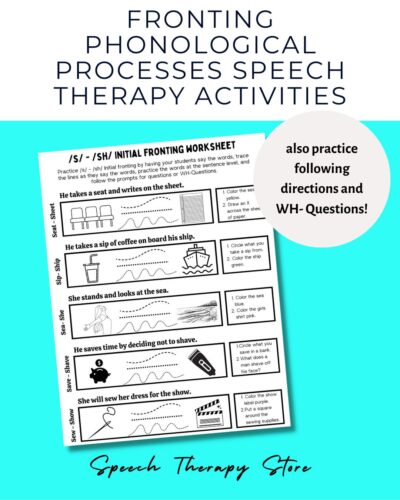
Understanding Phonological Processes
Phonological processes are natural patterns children use to simplify their speech as they learn and develop.
As speech and language professionals, we often work with children with phonological process disorders, which affect the patterns of sound errors as they learn to speak.
When these patterns persist beyond the expected age of elimination, it could mean a phonological delay or a phonological process disorder. This might cause children to struggle with speech intelligibility and affect their overall communication skills.
There are several different phonological processes that children may exhibit in their speech. The most common phonological pattern include:
- Velar Fronting: Replacing sounds made in the back of the mouth (velar) with sounds made in the front of the mouth (alveolar), such as “tar” for “car” or “date” for “gate”.
- Stopping: Substituting fricative or affricate sounds with a stop sound, like “pun” for “fun” or “tea” for “see.”
- Gliding: Replacing liquid sounds (l, r) with glide sounds (w, y). For example, “yike” for “like” or “wug” for “rug”.
- Cluster Reduction: Omitting one or more consonants from a cluster, such as “boo” for “blue” or “top” for “stop.”
It is important to address any atypical phonological processes in speech therapy. Using a phonological processes chart is an effective way to determine speech patterns in young children.
Early intervention is key when we are addressing these issues and teaching clear communication skills with our children and students!
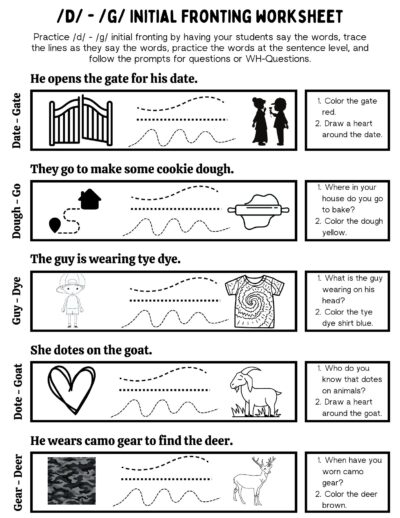
Recognizing Fronting Phonological Process
We can recognize fronting phonological processes through a few distinct examples. Take the word “car,” for instance, where the child might say “tar” instead. Here, the back sound /k/ is replaced with the front sound /t/. Similarly, in the word “gate,” the child may replace the /g/ sound with a /d/ sound, pronouncing it as “date.”
To help you identify the fronting phonological process, here are some key characteristics:
- Sounds affected: Velar sounds (k, g) are replaced by alveolar sounds (t, d).
- Pattern: Front sounds are produced using the front of the mouth or front of the tongue.
- Age of elimination: Typically eliminated by age 4.
One way to observe and assess the fronting process is by listening to children’s speech when they attempt to say words with back sounds. Pay attention to the sounds they produce and identify if they are consistently replacing the target back sounds with front sounds.
Additionally, you can examine a child’s articulation and tongue positioning while speaking. By examining their pronunciation and articulation, we can identify any patterns and provide appropriate guidance to help them overcome this process and improve their overall speech abilities.

Classification of Sounds
In the study of speech sounds, it is essential to understand the various classifications and types of sounds. This helps us to better grasp the concept of the fronting phonological process.
In speech production, there are two main categories of sounds, consonants and vowels. Within these categories, there are distinctions related to the place and manner of articulation, as well as voicing. Sounds can be produced in the front, middle, or back of the mouth. The primary focus in discussing fronting is on the back sounds and their replacements.
Velar sounds are produced in the back of the mouth, with the tongue making contact with the soft palate or velum. Examples of velar sounds include /k/ and /g/. When fronting occurs, these velar sounds are replaced by alveolar sounds, which are produced with the tongue contacting the alveolar ridge, just behind the upper front teeth. Examples of alveolar sounds include /t/ and /d/.
As we discuss the fronting phonological process, it is essential to note that it primarily involves the substitution of one sound for another, often transforming a back sound like a velar or palatal sounds into an alveolar sound or another sound produced closer to the front of the mouth. Understanding these classifications and types of sounds allows us to better analyze and address the impact of such sound changes on speech development and therapy outcomes.

SEE ALSO: 430+ Free Multisyllabic Words List Activity Bundle
Stages of Children’s Speech Development
- Prelinguistic stage (birth to 1 year): Noises and vocalizations are the primary forms of communication. At this point, children are not yet producing words but are learning to understand and respond to sounds around them.
- Single word stage (1 – 2 years of age): At this age, children begin to produce their first words or utterances. They often rely on some phonological processes to help them create speech, even if it’s not always intelligible.
- Two-word stage (2 – 3 years of age): Children begin to combine words to express more complex ideas. At this stage, phonological processes such as fronting still play an important role in a child’s speech development.
- Phoneme mastery (4 – 8 years of age): This phase marks efforts to refine language skills and patterns. During this time, most phonological processes should have ceased, indicating a more sophisticated level of language development.
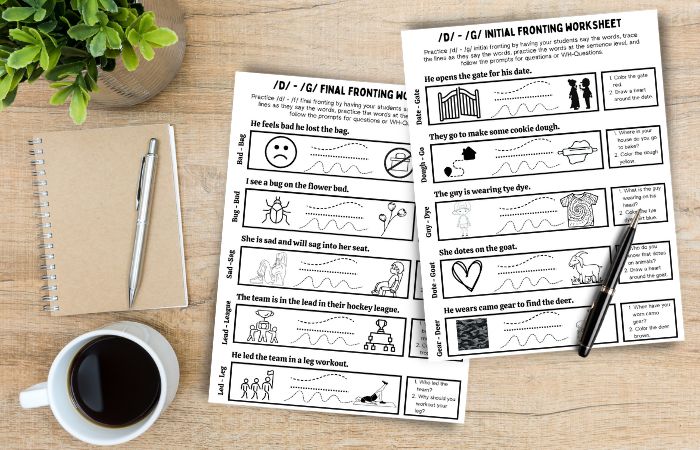
Word and Syllable Patterns
- Final Consonant Deletion – deletion of the final consonant in the word. Example: “ca” instead of “cat”, or “ba” instead of “bat”
- Initial Consonant Deletion – the initial consonant sound is deleted. Example: “ick” instead of “stick”. This is less common and may indicate phonological disorders.
- Weak Syllable Deletion/Unstressed Syllable Deletion – an unstressed syllable in a word is deleted. Example: “nana” for “banana” or “tato” for “potato”.
- Consonant Clusters – groups of consonants that appear together without any vowels between them.
- Consonant Cluster Deletion/Reduction – omitting one or more consonant, often because a child struggles with that consonant clusters, they may simplify these clusters by omitting one or more consonants. Example: “poon” instead of “spoon”
Understanding syllable structure and patterns is essential for language development. In English, there are three basic syllable structures: consonant-vowel (CV), vowel-consonant (VC), and consonant-vowel-consonant (CVC). Children may exhibit deletion, substitution, or replacement of consonants when they struggle with these patterns.
Recognizing and addressing these common word and syllable patterns in speech therapy can contribute to more effective language development for children experiencing the fronting phonological process. Remember that the resolution of these patterns often occurs naturally as a child grows, with the support and guidance of speech therapists and parents.
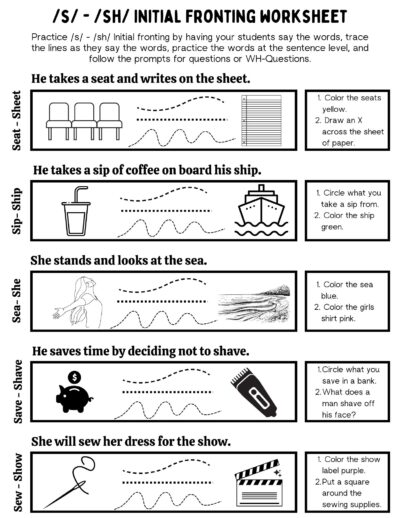
SEE ALSO: Best Handout for Phonological Processing Disorder Therapy
Speech and Language Therapy
In the field of speech and language therapy, fronting is a common phonological process that we encounter with clients who have an articulation disorder. As speech-language pathologists (SLPs), our goal is to help these individuals improve their speech through various therapy techniques.
During our speech and language therapy sessions, we employ a multitude of approaches to address fronting and other phonological processes. Here are some methods that we use to help our clients:
- Minimal Pairs Approach: A popular and longstanding intervention method in speech-language pathology that involves contrasting words that differ by only one sound. For example, if a child says “tea” instead of “key,” we might present them with the word pair and ask them to differentiate between the two. This helps the child notice the distinction between the target sound and their error.
- Auditory Bombardment: As part of the language therapy, we expose the client to the target words or sound repeatedly over a short period to help them become more aware of the correct pronunciation. This can be accomplished through listening to recordings, reading books with target sounds, or by the speech therapist continuously modeling the sound.
- Articulation Therapy: Articulation therapy focuses on training the specific movements required for accurate speech sound production. We may use visual cues, tactile prompts, or verbal instructions to guide the client through the correct placement of their tongue, lips, and jaw when producing the target sound.
- Phonological Awareness Activities: In order to facilitate the development of phonological awareness, we engage our clients in various language therapy exercises that target sound manipulation, such as rhyming, blending, and segmenting. These activities help improve the client’s ability to recognize and analyze the different sounds in words.
SEE ALSO: Stopping Phonological Process: What is it? [Free Worksheets]
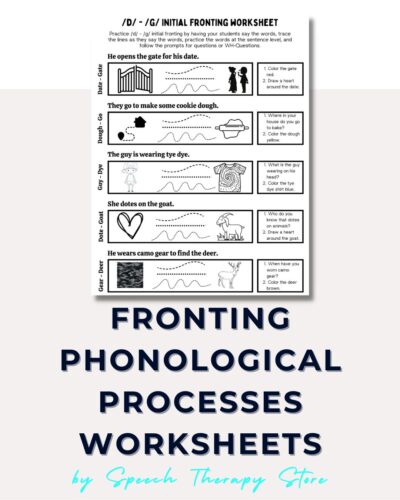
Auditory Aspects of Speech
To tackle the fronting phonological process with auditory aspects in mind, we often focus on:
- Providing auditory bombardment to increase exposure to correct sound production
- Identifying phonological errors and provide targeted intervention
- Addressing rule-based errors to rectify inaccurate speech patterns
- Improving speech clarity for unfamiliar listeners
- Encouraging the production of correct sounds and language development
By understanding the auditory aspects of speech, we can better support individuals with their phonological processing needs and enhance their communication abilities.

Overall Advancements and Considerations
It’s worth noting that fronting may persist in some children beyond the typical age of elimination, which suggests that intervention may be necessary. In these cases, it’s a good idea to consult a speech-language pathologist who can devise an appropriate treatment plan for each child. Some of the effective strategies for addressing fronting include:
- Auditory bombardment: Repeated exposure to target sounds to enhance children’s awareness of the correct pronunciation
- Multisensory cues: Combining visual, auditory, and tactile cues to facilitate learning and generalization of new speech sounds
- Focused drills: Repetitive practice of challenging words and phrases to improve motor planning and execution
ENTER YOUR NAME AND EMAIL BELOW FOR YOUR FREE FRONTING PHONOLOGICAL PROCESS WORKSHEETS
Frequently Asked Questions
What are some examples of fronting in children’s speech?
Fronting is a common phonological process in children’s speech where sounds made at the back of the mouth (e.g., velar sounds like /k/ and /g/) are replaced with sounds made at the front (alveolar sounds like /t/ and /d/). Examples of fronting include a child saying “tar” for “car” or “date” for “gate”.
At what age does fronting typically disappear?
Fronting typically disappears from a child’s speech by the age of 4. It is important to remember that speech development is highly variable, and individual children may eliminate fronting at slightly different ages.
How can parents help a child overcome fronting?
Parents can support their child’s speech development by modeling correct pronunciation, providing feedback, and encouraging their child to practice words with the targeted sounds. Additionally, seeking support from a speech-language pathologist can be beneficial, particularly if the child continues to demonstrate fronting beyond the age at which it should typically disappear.
What is the difference between fronting and other phonological processes?
Phonological processes are patterns that young children adopt to simplify adult speech sounds. Fronting is one such process. Other common phonological processes include stopping (e.g., replacing fricatives and affricates with stop consonant), cluster reduction (e.g., simplifying consonant clusters), and gliding (e.g., substituting glide sounds for liquids). Each phonological process impacts speech differently and may require targeted intervention strategies.
Is fronting a phonological or articulation error?
Fronting is considered a phonological error, as it involves the substitution of one class of sounds for another, rather than an incorrect production of individual sounds. Articulation errors, on the other hand, involve difficulty producing specific speech sounds accurately and consistently.
What are some activities to address fronting in speech therapy?
Speech therapists use various techniques and activities to target fronting in children’s speech. Examples include auditory bombardment (listening to words and sentences with target sounds), minimal pairs (practicing pairs of words that differ only in the fronted sound), and multisensory cueing (incorporating touch, visuals, and movement to teach correct sound production). A Speech Language Pathologist may also incorporate games and play-based activities to keep the child engaged and motivated during therapy sessions.
Want Even More Lesson Plans for Speech Therapy?
- Free SLP Planner [Updated Yearly]
- 917+ Best Free Boom Cards for Speech Therapy
- 31 Best Wordless Videos to Teach Problem Solving
- 133+ Categories List for Speech Therapy
- The Best Handout for Phonological Processing Disorder Therapy
Want the Best of the Bests?
Be sure to check out our most popular posts below!
- 21 Best Reinforcement Games for Speech Therapy / Teletherapy
- Best IEP Resources
- 71+ Free Social Problem-Solving Scenarios
- 430+ Free Multisyllabic Words List Activity Bundle
- 432+ Free Measurable IEP Goals and Objectives Bank
- 279+ Free Speech Therapy Digital Materials
- 179+ Free Speech Therapy Wh-Questions Printable
